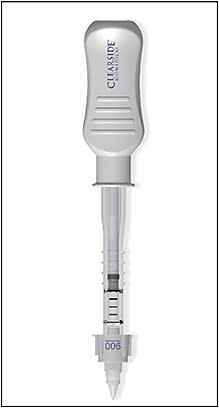A new route of administration is breathing life into a long-established treatment for macular edema. Bausch + Lomb’s Xipere (triamcinolone acetonide injectable suspension) delivers a unique formulation of the workhorse medication via the suprachoroidal space (SCS), leveraging the space’s expansion capabilities to allow targeted treatment of macular edema associated with uveitis.
“The SCS is an area that hasn’t been previously accessed from an FDA approval standpoint,” notes Steven Yeh, MD, professor of ophthalmology and director of Retinal Disease and Uveitis, Stanley M. Truhlsen Eye Institute, University of Nebraska Medical Center, and principal investigator for the Xipere phase 3 pivotal study. Indeed, Xipere is the first and only FDA-approved medication in the United States that utilizes this space — located between the sclera and the choroid — to enable targeted delivery of medication directly to the back of the eye.

THE BENEFITS OF DRUG DELIVERY TO POSTERIOR TISSUES
Drug delivery to the SCS offers previously unseen benefits for patients, including more targeted therapy, increased efficacy, and the potential for reduced side effects.
“Suprachoroidal administration is an innovative technique for delivering ocular therapies that may facilitate more targeted delivery of therapeutic agents to the retina and choroid,” says Yolande Barnard, senior vice president and general manager of Ophthalmic Pharmaceuticals, Generics and Market Access at Bausch + Lomb. “Suprachoroidal injection enables the rapid and adequate dispersion of medicine to the back of the eye, offering the potential for the medicine to act longer and minimize harm to the surrounding healthy parts of the eye.”
Suprachoroidal delivery also allows for higher bioavailability of the drug within the retina and the choroid, “allowing the efficacy signals of the drug to be demonstrated in a way that we don’t necessarily see with other medications,” adds Dr. Yeh.
THREE LINES OF IMPROVEMENT IN BCVA
Xipere is the first and only uveitic macular edema treatment to demonstrate clinical efficacy with a best corrected visual acuity (BCVA) primary endpoint. “Having BCVA as a primary endpoint was unique across clinical trials, as many others have looked at vitreous haze or other inflammatory markers,” explains Dr. Yeh.
In the PEACHTREE study — a randomized, multicenter, double-masked, sham-controlled phase 3 clinical trial — 47% of patients gained 3 lines of visual acuity from baseline compared to 16% of patients in the control arm. “Significant visual acuity gain is the most important thing to a patient with uveitis,” says Dr. Yeh. “Improved visual acuity translates to a very tangible improvement in patients’ quality of life and everyday functioning.”
Investigators noted improvement in BCVA regardless of the anatomic location of the uveitis. “I think that’s one unique aspect of data on Xipere,” adds Dr. Yeh. “Other uveitis clinical trials in the past have focused primarily on intermediate, posterior, and panuveitis, whereas the PEACHTREE trial was inclusive, including anterior uveitis.” Dr. Yeh noted that patients across all anatomic locations for uveitis “did well from a retinal edema perspective.” Plus, patients who received the SCS injection “showed metrics that included improvements in anterior-chamber inflammation that one may or may not expect to see with medication that’s primarily concentrated in the back of the eye.”
NO RESCUE THERAPY FOR NINE MONTHS
A significant portion of patients from the PEACHTREE study did not need rescue therapy for at least 9 months after their last Xipere injection, investigators found. The MAGNOLIA study, an extension study that looked at treatment durability, followed patients who went through the PEACHTREE study without needing additional medications beyond the 2 Xipere treatments.
“For individuals who made it out to the 24-week timeframe of PEACHTREE, 50% of patients did not need additional treatment beyond Xipere. The average time to rescue therapy from study enrollment was over 300 days,” says Dr. Yeh. “This means less time at the doctor’s office and more time to enjoy the quality of vision that they’ve gained. The durability of the medication is one aspect of SCS delivery that we’re continuing to learn more about.”
HOW XIPERE IS DELIVERED
The SCS Microinjector, a hollow microneedle designed in collaboration with biomedical engineering teams from the Georgia Institute of Technology, Emory University, and Clearside Biomedical, is a key part of effective delivery of Xipere. “The SCS Microinjector offers unprecedented access to the back of the eye where sight-threatening disease often occurs,” says Barnard. “It is designed to provide targeted and compartmentalized delivery and higher proportions of absorption relative to intravitreal injection.”
Bausch + Lomb offers training on the use of the SCS Microinjector via a publicly available training platform. The program consists of a didactic component, a video demonstration of the SCS injection technique, and a hands-on practical experience including the opportunity to receive peer-to-peer feedback from clinicians who have been trained with the SCS Microinjector. “It’s a new drug delivery method,” adds Dr. Yeh. “It is nuanced and requires clinicians to learn a new technique.”
A NEW FRONTIER
The SCS is a novel route for ocular drug administration that offers promise, with safety and efficacy shown in multiple clinical studies. And while to date, no head-to-head clinical studies have been conducted comparing Xipere to other drugs that utilize triamcinolone acetonide, other active steroids or other medication, the potential of the SCS cannot be underestimated.
“The suprachoroidal space is an untapped and exciting new frontier in eye health,” says Barnard. “We are hopeful that the approval of Xipere as the first treatment to utilize the suprachoroidal space for drug delivery opens the door for further exploration of this administration route as an alternative route in retinal disease management.” Dr. Yeh agrees. “We are just beginning to scratch the surface of what we know about the SCS drug delivery platform.” RP








